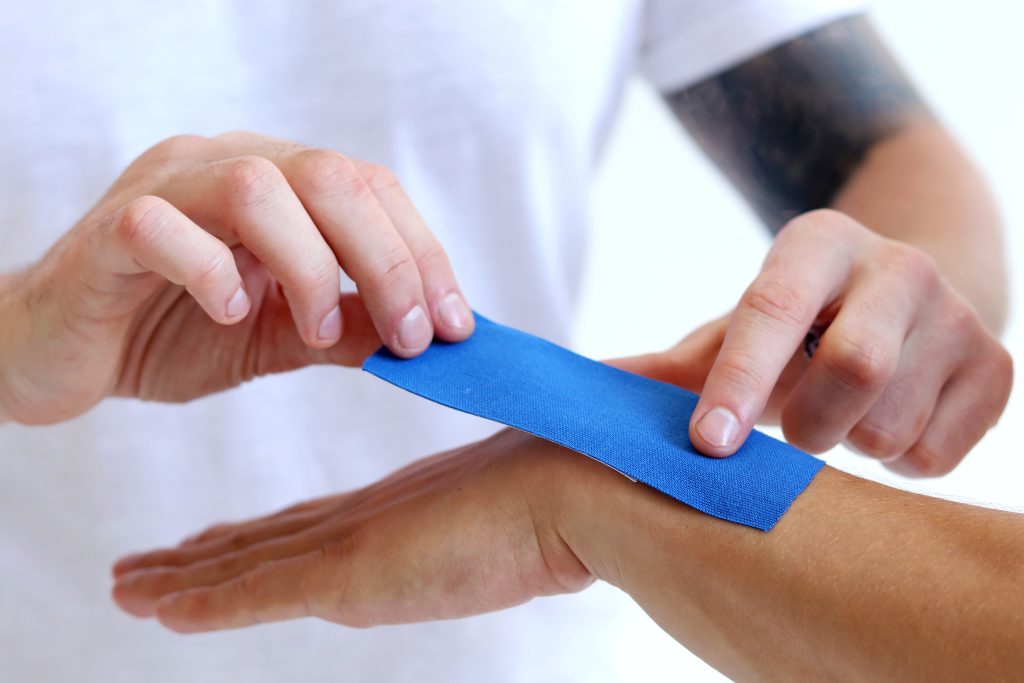For the modern office worker, carpal tunnel has become both a buzzword and a genuine health concern. Hours spent typing, clicking, and scrolling day after day can leave your wrists aching and your fingers tingling. The condition affects millions of people worldwide, transforming simple tasks both at your desk and throughout your life into painful reminders of overuse.
Traditional treatment methods for carpal tunnel syndrome often require lifestyle changes, ergonomic adjustments to your workspace, or committing to a daily wrist exercise regimen. These approaches can be effective, but they demand time and consistent effort. Kinesio tape can be used in conjunction with traditional physical therapy as a way to give your wrists extra support and reduce pain during your daily activities.
What is kinesiology tape?
Kinesiology tape, also known as KT tape or kinesio tape, is a thin, stretchy adhesive tape that is applied to specific areas of the body. The tape is designed to gently and flexibly pull the skin and underlying tissues of the taped area to provide better blood flow and lymphatic drainage, as well as to support and protect underlying muscles. KT tape was made popular in the mid- to late-2000s due to its use by high-profile athletes in the Olympics and other sports.
The tape’s unique properties set it apart from traditional athletic tape. KT tape is applied while stretched to provide constant elasticity to the area for extra support. In contrast, traditional athletic wraps constrict areas of treatment, which does provide support, but limits flexibility and reduces circulation in the area.
You’ve likely seen kinesiology tape in action during sporting events, where athletes sport colorful strips across their shoulders, knees, and legs. At Armor, we use it most often to provide targeted support to help with joint pain as well as muscle imbalances. Its breathable, waterproof design allows it to stay in place for several days, making it a convenient option for continuous support.
Causes of carpal tunnel syndrome
Understanding why carpal tunnel develops helps explain how kinesiology tape might fit into a prevention strategy. Carpal tunnel syndrome occurs when the median nerve, which runs through a narrow passageway in your wrist called the carpal tunnel, becomes compressed or irritated.
The most common culprit behind this compression is repetitive wrist movement, particularly activities that involve flexing your wrist downward or maintaining awkward wrist positions for extended periods. Office workers and people who use a phone or tablet a lot face particularly high risk of wrist strain and carpal tunnel especially when devices or your desk height forces the wrists into unnatural angles.
So, if carpal tunnel syndrome is caused and/or worsened by wrist use in awkward or unsupported postures, can KT tape help treat it?
Does KT tape help carpal tunnel?
Some physical therapists use carpal tunnel KT tape techniques as a step toward preventing the condition after early signs of strain are present.
The idea is that the tape may provide gentle support to the wrist structures, potentially helping maintain better wrist alignment during daily activities. This support may reduce the excessive flexion and extension that contributes to median nerve compression.
Additionally, the tape’s potential circulatory benefits may help reduce inflammation in the early stages of carpal tunnel development. Improved blood flow can support tissue health and potentially slow the progression of symptoms in mild cases.
Our PTs have experience using KT tape all over the body, including the arms and wrists, to ensure you get the right support in exactly the right area.
Other carpal tunnel treatment options
For those dealing with moderate to severe carpal tunnel symptoms, several evidence-based treatment options offer more substantial relief than taping alone.
Wrist braces or splints
Wrist splints or braces remain the most effective conservative treatments for moderate carpal tunnel syndrome, especially for nighttime use.
Unlike kinesiology tape, rigid or semi-rigid splints maintain the wrist in a neutral position that maximizes the space within the carpal tunnel. Wearing splints also prevents the wrist from flexing while you sleep, which can significantly worsen carpal tunnel symptoms.
Changing your work setup
Ergonomic modifications to workstations can provide substantial long-term benefits for your wrists and whole body. Adjusting keyboard height, using an ergonomic mouse, taking regular breaks, and implementing proper typing techniques address the root causes of repetitive strain.
These changes, while requiring initial effort and investment, often provide more lasting relief than supportive taping.
Physical therapy treatment
Physical therapy offers a comprehensive approach to wrist pain that may include manual therapy techniques, specific exercises to improve nerve mobility, and education about activity modification.
Our Physical Therapists can teach targeted stretches for the wrists and forearms, strengthening exercises for the supporting muscles, and proper body mechanics to reduce the risk of future strains.
Often, the key to successful carpal tunnel treatment and prevention lies in combining multiple approaches tailored to your specific situation, symptoms, and lifestyle factors.
Carpal tunnel relief at Armor Physical Therapy
Wrist pain and carpal tunnel syndrome don’t have to limit your daily life. At Armor Physical Therapy, our experienced team understands that effective carpal tunnel treatment goes beyond quick fixes. We develop personalized treatment plans that address your specific symptoms, work demands, and lifestyle factors. Our therapists can properly assess whether kinesiology tape is appropriate for your situation and teach you correct application techniques if it fits your treatment goals.
We’re happy to answer your questions and get you on a treatment plan for the wrist pain you’re dealing with when you call one of our clinics or request your first appointment online.
